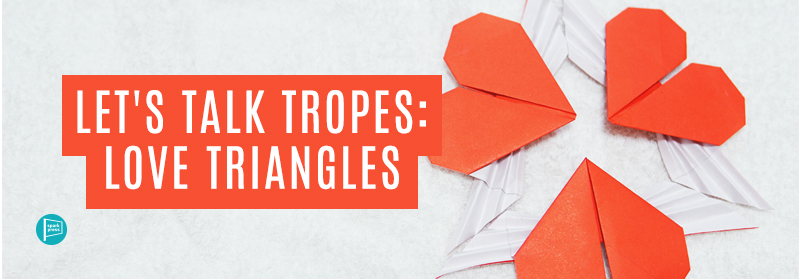
“Most of these love triangles are wrecktangles.” —Jacob Braude
What is a Love Triangle?
The Love Triangle trope in writing is to show a romantic relationship involving, at minimum, three people. Usually, two of which are competing against each other for the individual, undivided attention of a single interest. This trope is one of the most popular and recognizable across all forms of fiction. Inevitably, there is jealousy, heartbreak, and the pairing off of a couple.
Who is in a Love Triangle?
The Love Triangle is often as simple as two male characters trying to win the attention of the female character. One of the most famous Love Triangles in history that follows this format is from Arthurian Tales. King Arthur is married to Queen Guinevere, but Queen Guinevere is having a not-so-secret love affair with Sir Lancelot, King Arthur’s best friend.
There are different types of love triangles, such as a Love Dodecahedron. This is a multi-layered love triangle, with way too many players. For example, Percy Jackson, from the Percy Jackson (and The Heroes of Olympus) series by Rick Riordan, is liked by several characters throughout the books including Annabeth Chase, Rachel Dare, Calypso, Reyna, and Nico di Angelo. Despite Percy having mutual feelings for some of these characters, his main love interest is Annabeth Chase, but even she has a publicly known crush on the archenemy Luke. When it does seem like Annabeth and Percy have a chance to express their feelings, Rachel Dare jumps into the mix and distracts Percy. The love triangles between all these characters are frustrating and sometimes hard to keep up with. Yet, we cannot get enough of the chaos.
No matter what design is being used, this trope is seen through the centuries and throughout mythologies and classic texts. The Greek goddess Aphrodite is married to the god Hephaestus, but she is having an affair with the other Greek god, Ares. Shakespeare employs his famous love triangle trope in his play A Midsummer Night’s Dream. Famous love triangles include The Hunger Games, The Hunchback of Notredame, Wuthering Heights, and Twilight. While this trope is popular in children’s and young adult literature, it is also seen in classical fiction. It can be seen in F. Scott Fitzgerald’s The Great Gatsby, and Edith Wharton’s The Age of Innocence.
Problems with a Love Triangle
Love Triangles are hard to pull off. Most of them are heteronormative and lack diversity. They can employ sexist stereotypes and clichés. It is “normal” for society to see two men fighting for a woman. This can insert implications that the girl is a trophy to be won. The reverse, two or more girls attacking each other for the attention of a guy, can seem out of touch plagues the male character as a “player.”
A lot of times the love triangle trope is in use because the plot or the characters are flat. It is very apparent when a character is there to only be a love interest. If this trope is in play, then it should be necessary and relevant to the plot. The Hunger Games by Suzanne Collins uses the love triangle between Katniss, Peeta, and Gale as a plot device. Love is not only used to create conflict, but it is also a survival skill and overall theme throughout the book and characters. When the author is able to connect the relationships to the development of the plot it feels more natural to the readers.
When it comes to love triangles, some readers are ultimately going to be disappointed. The character who has better chemistry with the protagonist might not “win over” the character in the end. This usually leads to a lack of sympathy for the protagonist, which is a problem. Newland Archer, from The Age of Innocence by Edith Wharton, is not seen as the victim of his story. As the male character between two female characters, he comes off as a modern-day misogynist. Engaged to May Welland, Newland starts an illicit affair with May’s cousin, Countess Ellen Olenska. His love for Ellen never fades, but his breaking heart is not accounted for because of his relationship with May.
Why We Love a Good Love Triangle
A love triangle can help a character can grow and learn individually. A lot of times, these tropes are seen in younger characters. Their ideals and values are maturing and developing and it is seen in how they handle the relationships at hand, both individually and towards the other characters. When the connections are genuine and natural, the trope is easier for the reader to digest. If the ending is shocking, it can upset the reader and the plot as a whole. The end of Katniss Everdeen’s love triangle in The Hunger Games is aggravating to readers and makes them upset with the book as a whole.
This trope stands the test of time because it creates tension, encourages character development, and invites emotional investment. The love triangle is versatile like any good trope is. It comes in numerous forms, through countless stories, and with emotional or emotionless characters. The Love Triangle trope can be a subversion of the plot or the central theme. Either way, it is hard to not entangle yourself in the juicy and enticing drama of a character’s love life.

Leave A Comment